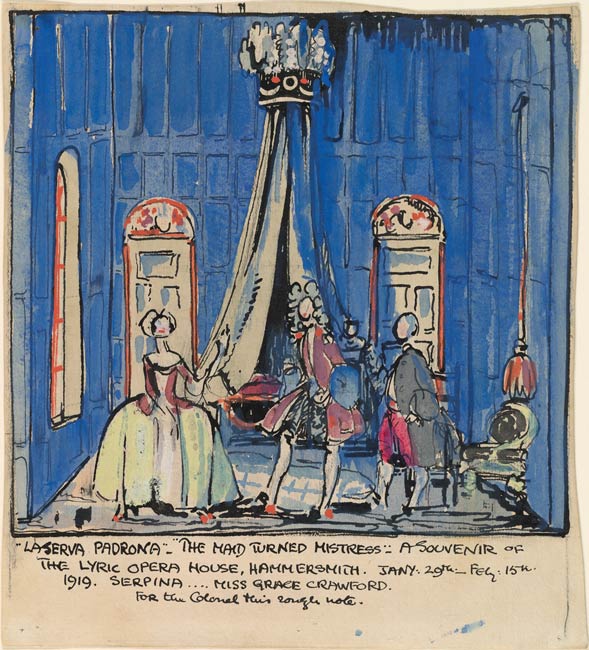
This work is drawn on a sheet of paper containing a printed announcement for "The Chelsea Arts Club Costume Ball".
Inscribed in at bottom in pen and black ink, " 'LA SERVA PADRONA' - 'THE MAID TURNED MISTRESS' - A SOUVENIR OF / THE LYRIC OPERA HOUSE, HAMMERSMITH. JANY: 29TH - FEB: 15TH / 1919. SERPINA .... MISS GRACE CRAWFORD. / For the Colonel this rough note."
Claud Lovat Fraser, whose mother was an amateur artist, was active as an illustrator and theater designer. While a young practicing lawyer, he joined a group of artist and critics who frequented Dan Rider's Den, a printer's shop, where Fraser produced sketches lampooning contemporary literary figures and theater performers. During World War I, Fraser was commissioned to the 14th Battalion of the Durham Light Infantry and he recorded his experiences intimately in sketchbooks and drawings. He would later die in 1921 from war-time exposure to gas.
The present sheet was made in preparation for an Italian opera, La Serva Padrona, an opera buffa that premiered in Naples in 1733 by Giovanni Battista Pergolesi (1710-1736). The opera was short--only 45 minutes long--and meant to be performed as an intermezzo between a serious opera's longer acts. In 1916 Fraser met and later married the American-born actress Grace Inez Crawford while she appeared in Hugo Rumbold's L'Apres Midi d'un Faune. His wife's theatrical interests contributed to Fraser's activities in stage and costume design, and the two collaborated on many projects, including her translation of La Serva Padrona, in which she starred.
After the war, Fraser designed the many sets for the Lyric Theater, Hammersmith and La Serva Padrona was the first production where Fraser controlled the compete setting. Fraser noted the date of the performance's run--29 January to 15 February 1919--in an inscription. The present drawing was made as a souvenir of the play for "the Colonel."
Some of Frasers's sets were mockingly called "futurist" because of their reductive design. In fact, the set of La Serva Padrona was celebrated by its producers precisely for its economy: "Lovat Fraser got his effects [on La Serva Padrona] actually by not spending money, and designed scenery which was not only much better than the conventional stuff--it was mechanically ten times as efficient, and financially at least several times as cheap" (Sir Nigel Playfair, The Story of the Lyric Theater, Hammersmith [1925], page 30). Nonetheless, La Serva Padrona failed at the box-office.
The opera buffa features Uberto, an old man; Serpina, his maid (played by Fraser's wife); and Vespone, his servant who are all shown in this drawing. Fraser places the scene in Uberto's dressing room, where both of the intermezzo's acts were set.
